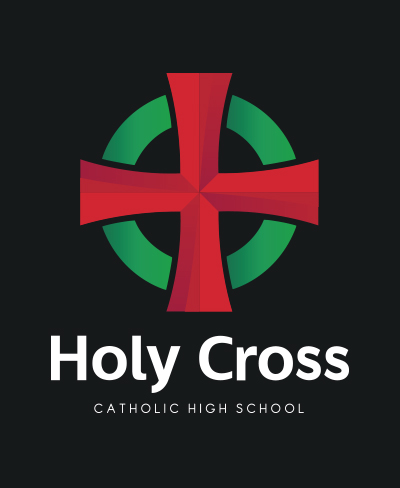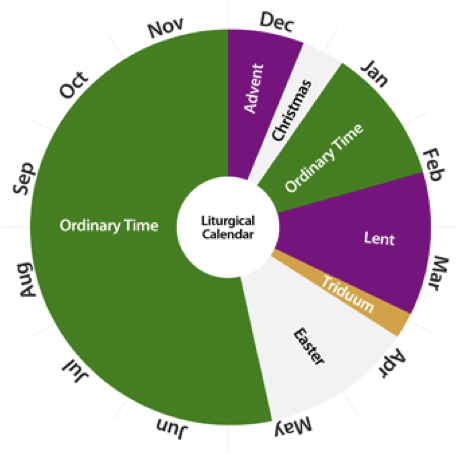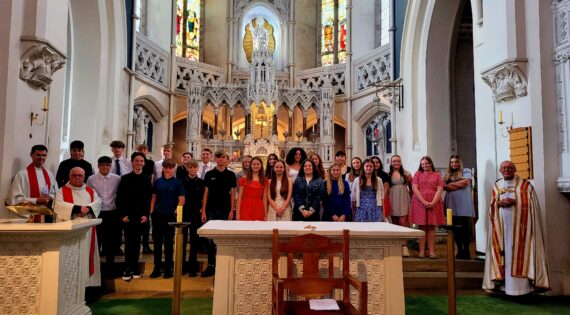Our school prayer life is based on the Liturgical Calendar, a cycle of seasons and days which celebrate and commemorate the life of Jesus Christ. The calendar organises the year into different liturgical seasons, with specific themes, colours, readings and observances for each: Advent, Christmas, Lent and Easter. In between these seasons are the periods known as Ordinary Time. The calendar also includes feast days for saints and other important figures in Christian history and other significant celebrations within the Church and it is often added to so that it reflects local and regional celebrations.
Advent
Advent begins on the Sunday closest to the feast of St Andrew, which is November 30. It is a time of waiting and preparing for the coming of Jesus.
The liturgical colours of Advent are purple and rose, with rose being used only on the third Sunday of Advent, known as Gaudete Sunday.
Christmas
The Christmas season begins with the celebration of the birth of Jesus, Christmas day, or as a vigil on Christmas Eve. The Feast of Christmas lasts for 12 days, until the Feast of the Epiphany, but the season continues until the Feast of the Baptism of the Lord, which is celebrated on the Sunday following Epiphany.
The liturgical colour of Christmas is white.
Ordinary Time
There are two periods of Ordinary Time in the Liturgical Calendar: the time from the Feast of the Baptism of the Lord until Shrove Tuesday; and the time between Pentecost and Advent. Ordinary in this context does not mean plain, but comes from ‘ordinalis’ referring to the order of the weeks.
The liturgical colour of Ordinary Time is green, although there may be occasions during ordinary Time when other colours are used, for example, on feast days.
Lent
Lent begins with Ash Wednesday and continues until Holy Saturday. Excluding Sundays, Lent is 40 days long reminding us of the 40 days Jesus spent in the desert and the 40 years the Israelites wandered in the desert.
The liturgical colours of Lent are violet or purple, with rose being used for the fourth Sunday, known as Laetare Sunday.
On Passion Sunday (Palm Sunday) and on Good Friday the colour is red.
White is used for Holy Thursday and Holy Saturday.
Easter
The season of Easter begins with the Easter Vigil, celebrated after nightfall on the evening before Easter Sunday. It lasts for 50 days, until Pentecost.
The liturgical colours of Easter are white, for most days, and red for Pentecost.
Other dates in the Calendar
The Feast of the Exaltation of the Cross
Our school Feast Day takes place on 14 September. The liturgical colour is red.
Creation Time
The time from 2 September until the Fest of St Francis of Assisi on 4 October is designated Creation Time. We celebrate Creation Mass at St Gregory’s and our prayer spaces will reflect the glory of God’s creation.
The Month of the Holy Rosary
During October, we make a special effort to pray the Rosary. During this time, the colour used for our prayer spaces is blue.
November
November is a month of remembrance, for those who dies in war and for our friends and family who have died. The colour used in our prayers spaces is black,
Octave of Prayer for Christian Unity
Between 18 and 25 January, we pray for the unity of Christians across the world.
The month of Mary
May is the month of Mary, when we focus again on the importance of the Mother of God. The colour for our prayer spaces is blue.
Holydays of Obligation
There are six Holydays of Obligation in the Liturgical Calendar:
- Nativity of the Lord (25 December)
- Epiphany of the Lord (6 January)
- Ascension of the Lord (Thursday after 6th Sunday of Easter)
- St Peter & St Paul (29 June)
- The Assumption of the Blessed Virgin Mary (15 August)
- All Saints (1 November)
With the exception of the Nativity of the Lord and the Ascension, when these dates fall on a Saturday or a Monday, they will be transferred to the Sunday.
Discover more
© Holy Cross Catholic High School, 2025. All Rights Reserved.



